
Indicator scoreboard
EMU - October seasonally adjusted PMI services index dropped to 46.7 from 49 in September. Every subindex fell, led by sharp declines in new and outstanding business to the lowest levels in survey history. An index reading above 50 signals that activity is expanding, a reading below 50 signals contraction; the lower the reading below 50, the stronger the decline. The composite index, which combines service and industrial sector PMI readings, fell from 48.1 in September to 45.2 in October, the lowest level in over three years.
July seasonally adjusted unemployment remained unchanged at 8.3 percent. Of the nine EMU states reporting data, unemployment fell in one, rose in two and remained unchanged in six. Spain continued to show the highest unemployment rate - 13.0 percent.

September industrial producer prices (excluding construction) rose 0.1 percent and 0.7 percent when compared with last year. Energy goods sector prices rose 0.9 percent. But despite the monthly rise, energy goods prices fell 2.2 percent on the year.

October preliminary "flash" estimate of harmonized consumer prices fell 0.1 percent but rose 2.4 percent when compared with last year. The flash estimate - released for the first time points to a further gradual deceleration in inflationary pressures.
August real inflation and workday seasonally adjusted retail sales rose 0.3 percent and 1.8 percent on the year. Food, drinks and tobacco sector rose 1.7 percent when compared with last year while the non-food sector advanced by 1.5 percent. Textiles, clothing and footwear sector rose 0.5 percent while household goods gained 1.0 percent.

Final second quarter gross domestic product crept up 0.1 percent and 1.7 percent on the year. Consumer spending was revised up to 0.6 percent from 0.4 percent while inventories were revised down to a decline of 0.1 percent from no change.
EU - October economic sentiment index fell sharply to 99.1 from 100.1 in September - the tenth straight month of deterioration and the lowest level since July 1997. It reflects the heightened uncertainty following the September 11 terror attacks. Both industrial and consumer sentiment declined. Industrial confidence fell to minus 16 from minus 12 in September - the lowest since September 1996. Consumer confidence fell to a reading of minus 11 from minus 9 in September - the lowest since September 1997. The decline in consumer confidence was due in large part to a less optimistic view about the general economic situation over the next 12 months. Following the commission's recent modifications to the calculation of its economic sentiment index, industrial confidence now accounts for 40 percent of the weighting in the total index. Consumer confidence, retail trade and construction confidence each account to 20 percent.

Germany - October seasonally adjusted unemployment rate rose to 9.5 percent from 9.4 percent in September. Unemployment rate remained at 7.5 percent in west Germany but jumped to 17.8 percent from 17.6 in September in east Germany. October seasonally adjusted pan-German unemployment rose 27,000. The rise - the 10th in as many months this year - was due to the weaker world economy and structural problems. Unemployment rose by 10,000 in west Germany and 17,000 in east Germany.

September manufacturing orders plunged 4.1 percent. Orders dropped 5.1 percent in west Germany but were up 7.6 percent in east Germany. Orders in all manufacturing sectors - both domestic and foreign - declined. Durable and non-durable consumer goods orders fell 6.0 percent on the month after a 0.6 percent decline in August. Seasonally and inflation adjusted domestic manufacturing orders sank 3.6 percent and 6 percent when compared with last year. Seasonally and inflation adjusted foreign sales fell 5 percent and 7.3 percent when compared with last year.
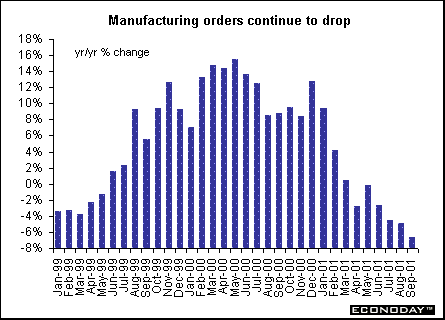
September seasonally adjusted industrial production fell 2.0 percent almost offsetting the rise in August. Industrial production fell 1.8 percent in west Germany and dropped 4.2 percent in east Germany. Most industrial sectors declined with only energy output rising slightly on the month. Manufacturing sector output (combining basic goods, capital goods and consumer goods and excluding all energy goods but including non-energy mining) fell 2.1 percent after it rose 2.4 percent in August.
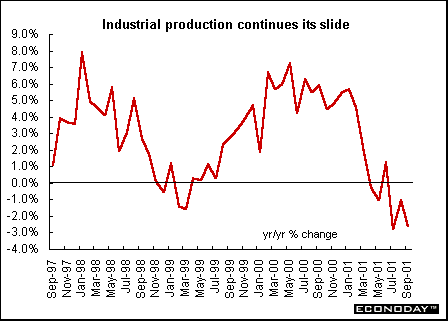
Britain - October seasonally adjusted service sector Purchasing Managers Index fell to 46.3 from 48.1 in September, the second month in a row below 50 and signaling contraction. The lower the index below 50, the faster the contraction. All major index components fell in October, with several posting all time lows.
September industrial production fell 1.2 percent and 3 percent on the year. The manufacturing sector dropped 1.6 percent and was down 3.7 percent on the year. Manufacturing output plunged to its lowest level since May 1992.
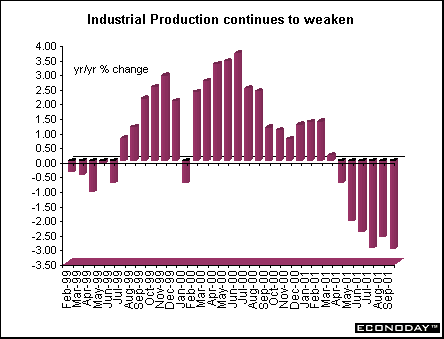
October Halifax house price index fell 0.5 percent but is 9.4 percent above levels of a year ago. The weakening in house prices is largely in response to a general easing in economic growth, deteriorating employment prospects and the blow to confidence following September's terrorist attacks.
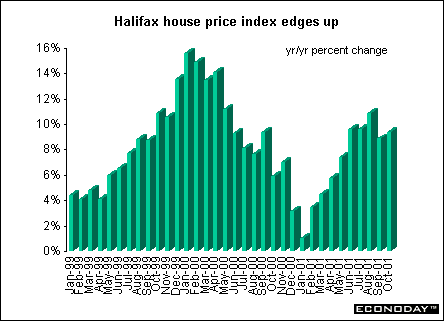
Asia
Japan - September seasonally adjusted spending by households of two or more people fell 0.3 percent following a 1.2 percent drop in August led by declines in housing and home repairs. From a year earlier, spending fell 3.7 percent, the sixth straight decline. Consumer spending accounts for about 55 percent of Japan's economy.
September seasonally adjusted machine orders (excluding shipping and electric companies orders) fell 13.2 percent to a two year low. Orders in the quarter fell 5.7 percent from the previous three months. Orders from service companies fell 15.6 percent led by transportation companies, wholesalers and retailers. Manufacturers' orders fell 18.4 percent, led by a decline in demand from makers of chips and autos. The most closely watched measure of machinery orders excludes those by shippers and power utilities as large projects typical of those industries skew the numbers. Foreign orders, which account for a quarter of all machinery orders, fell 5.0 percent. Overall orders, including the shippers, utilities and the government fell 6.6 percent.
Australia - October unemployment rate rose to 7.1 percent from 6.7 percent in September. This is the highest rate since May 1999 and the biggest monthly increase in three years. The economy lost 56,800 full time jobs, though that was balanced by 74,700 extra part time positions, for a net gain of 17,900 jobs. The unemployment rate rose as more people looked for work. The participation rate rose to 63.8 percent from 63.5 percent.
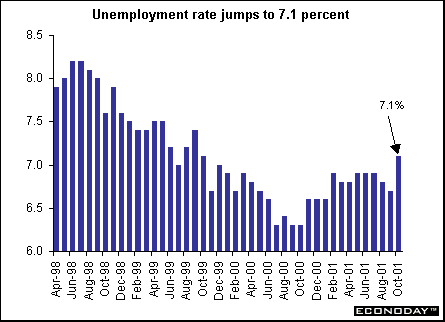


Introduction • Global
Stock Market Indexes • Recap of Global Markets
• Currencies • Indicator
Scoreboard

The Bottom Line •
Looking Ahead
|